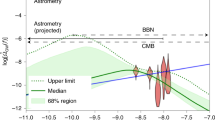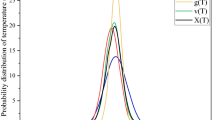Abstract
Grand unification theories (GUTs) suggest that massive magnetic monopoles (mass ∼1016 GeV) were created in the very early stages of the formation of the Universe. The report, 3 years ago1, of a candidate cosmic magnetic monopole therefore stimulated intense experimental and theoretical activity2,3. These monopoles should have the magnetic charge h/e predicted by Dirac4, or perhaps small integer multiples of h/e, but zero electric charge. Surviving magnetic monopoles are thought to be moving so slowly, v/c = 10−3 or less, that they interact exceedingly weakly with matter. For this reason, conventional particle detectors (whose mechanism is electronic ionization or excitation) are expected to be rather insensitive5, so that inductive detectors are particularly attractive. We describe here the results of 6 months observation with a large inductive detector. Some putative events have been seen, but none of them seem to have been induced by a monopole. Our total exposure (detector area–time product) is now about 230 times that of Cabrera's first experiment, so that it seems increasingly likely that his original candidate event was spurious.
This is a preview of subscription content, access via your institution
Access options
Subscribe to this journal
Receive 51 print issues and online access
$199.00 per year
only $3.90 per issue
Buy this article
- Purchase on Springer Link
- Instant access to full article PDF
Prices may be subject to local taxes which are calculated during checkout
Similar content being viewed by others
References
Cabrera, B. Phys. Rev. Lett. 48, 1378–1381 (1982).
Carrigan, R. A. Jr & Trower, W. P. (eds) Magnetic Monopoles (Plenum, New York, 1983).
Stone, J. L. (ed.) Monopole ‘83’ (Plenum, New York, 1984).
Dirac, P. A. M. Proc. R. Soc. A133, 60–72 (1931).
Ahlen, S. P. in Monopole ‘83’ (ed. Stone, J. L.) 629–635 (Plenum, New York, 1984).
Parker, E. N. in Monopole ‘83’ (ed. Stone, J. L.) 125–136 (Plenum, New York, 1984).
Park, J. G. & Guy, C. N. in Magnetic Monopoles (eds Carrigan, R. A. Jr & Trower, W. P.) 208–211 (Plenum, New York, 1984).
Guy, C. N. in Monopole ‘83’ (ed. Stone, J. L.) 125–136 (Plenum, New York, 1984).
Incandela, J. et al. Phys. Rev. Lett. 53, 2067–2070 (1984).
Gardner, R., Cabrera, B., Taber, M. & Huber, M. Proc. 17th int. Conf. on Low Temperature Physics 945–946 (North-Holland, Amsterdam, 1984).
Tesche, C. D., Chi, C. C., Tsuei, C. C. & Chaudhari, P. Appl. phys. Lett. 43, 384–386 (1983).
Schouten, J. C. et al. J. Phys. E. (submitted).
Cabrera, B., Taber, M., Gardner, R. & Bourg, J. Phys. Rev. Lett. 51, 1933–1966 (1983).
Author information
Authors and Affiliations
Rights and permissions
About this article
Cite this article
Caplin, A., Guy, C., Hardiman, M. et al. New upper bound on the flux of cosmic magnetic monopoles. Nature 317, 234–236 (1985). https://doi.org/10.1038/317234a0
Received:
Accepted:
Issue Date:
DOI: https://doi.org/10.1038/317234a0
This article is cited by
-
Observation of an unexplained event from a magnetic monopole detector
Nature (1986)
-
Particle physics: Real and imaginary monopoles
Nature (1985)
Comments
By submitting a comment you agree to abide by our Terms and Community Guidelines. If you find something abusive or that does not comply with our terms or guidelines please flag it as inappropriate.



